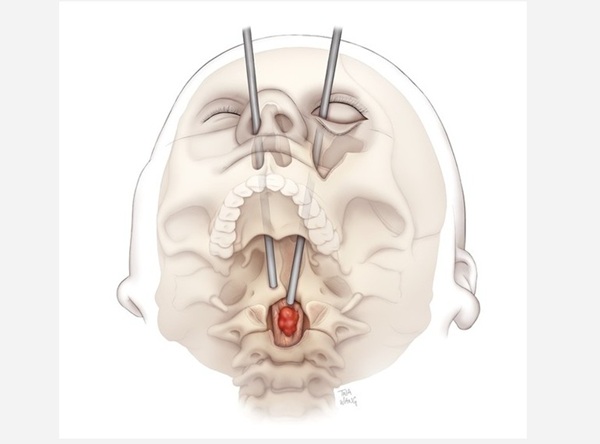BALTIMORE, MD—In a groundbreaking surgical procedure, doctors at the University of Maryland Medical Center removed a Baltimore County woman’s rare spinal tumor by accessing it through her eye socket, a method neurosurgeon Dr. Mohamed Labib hopes will open new avenues for treating difficult-to-reach tumors.
The journey for 19-year-old Karla Flores, of Rosedale, began at age 18 with double vision, leading to a diagnosis of a chordoma — a slow-growing, malignant tumor — wrapped around her brain stem. Chordomas are exceedingly rare, with only about 300 diagnoses annually in the U.S., according to the Cleveland Clinic.
Dr. Labib, who led Flores’ treatment, devised a two-part surgical plan for the brain stem tumor. However, a serendipitous positioning error during a pre-operative MRI revealed a second, even more precarious chordoma at the top of Flores’ spine, wrapped around her spinal cord and invading neck vertebrae.
“They told me if they hadn’t seen it, I could have been paralyzed,” Flores told CBS News.
Despite the shocking discovery, Labib proceeded with the removal of the first chordoma, successfully excising it through a traditional neurosurgery and a transnasal procedure.
The second tumor, however, presented a unique challenge due to its location, making traditional spinal approaches or a repeat transnasal procedure unfeasible. After consulting with colleagues, one of whom suggested palliative care, Labib refused to give up.
He spent weeks in UMMC’s neurosurgery laboratory, perfecting a novel technique he dubbed the “third nostril” approach. This involved accessing the tumor through the side of Flores’ eye, a method he had used once before, but never for a spinal tumor. Practicing on cadaver heads and skull models, Labib and his team meticulously prepared, even modifying surgical instruments.
When Labib presented the audacious plan to Flores and her family, her mother cried, and her father, typically stoic, was visibly concerned. Flores, however, put her trust in Labib’s surgical team.
During the approximately 20-hour surgery, facial plastic and reconstructive surgeon Dr. Kalpesh T. Vakharia created an opening by removing part of Flores’ eye socket and cheekbone, allowing Labib and head and neck surgeon Dr. Andrea Hebert to drill through vertebrae and meticulously dissect the tumor. Vakharia then rebuilt Flores’ eye socket with a titanium plate and her cheek with bone from her hip, leaving no external scars.
“It was perfect,” Labib said of the tumor’s complete removal.
Following the surgery, Flores underwent spinal stabilization and six weeks of radiation. Nearly a year later, she shows no evidence of cancer. While nerve damage from the chordoma still affects her left eye movement, she is continuing physical therapy.
Now 20, Flores hopes to pursue a career as a manicurist once her health fully recovers. She faces significant medical debt, with a GoFundMe campaign raising only a fraction of the estimated $600,000 owed.
“I keep reminding myself to take one day at a time and know that each step is an accomplishment,” Flores said. “I’m also glad I stood my ground and kept looking for help until I found it.”
Labib believes this innovative “third nostril” approach holds promise for future complex tumor removals. “I think this opens a new corridor for approaching tumors that are in the upper cervical (or high part of the) spine,” he said. “I think this third nostril approach is a smaller, easier and cleaner approach, and I think it’s going to really take on these difficult tumors in front of the spinal cord.”

Featured illustration via the University of Maryland Medical Center


